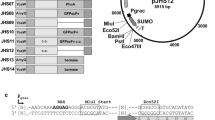Abstract
Tk1884, an open reading frame encoding α-amylase in Thermococcus kodakarensis, was cloned with the native signal sequence and expressed in Escherichia coli. Heterologous gene expression resulted in secretion of the recombinant protein to the extracellular culture medium. Extracellular α-amylase activity gradually increased after induction. Tk1884 was purified from the extracellular medium, and its molecular mass determined by electrospray ionization mass spectrometry indicated the cleavage of a few amino acids. The N-terminal amino acid sequence of the purified Tk1884 was determined, which revealed that the signal peptide was cleaved between Ala26 and Ala27 by E. coli signal peptidase. To the best of our knowledge, this is the first report describing an archaeal signal sequence recognized and cleaved by E. coli signal peptidase.
Similar content being viewed by others
References
Tuteja, R. (2005) Type I signal peptidase: an overview, Arch. Biochem. Biophys., 441, 107–111.
Schatz, G., and Dobberstein, B. (1996) Common principles of protein translocation across membranes, Science, 271, 1519–1526.
Bardy, S. L., Eichler, J., and Jarrell, K. F. (2003) Archaeal signal peptides–a comparative survey at the genome level, Protein Sci., 12, 1833–1843.
Von Heijne, G. (1990) Protein targeting signals, Curr. Opin. Cell Biol., 2, 604–608.
Brockmeier, U., Caspers, M., Freudl, R., Jockwer, A., Noll, T., and Eggert, T. (2006) Systematic screening of all signal peptides from Bacillus subtilis: a powerful strategy in optimizing heterologous protein secretion in Gram-positive bacteria, J. Mol. Biol., 362, 393–402.
Ng, S. Y., Chaban, B., VanDyke, D. J., and Jarrell, K. F. (2007) Archaeal signal peptidases, Microbiology, 153, 305–314.
Lee, S. Y. (1996) High cell density culture of Escherichia coli, Trends Biotechnol., 14, 98–105.
Marston, F. A. (1986) The purification of eukaryotic polypeptides synthesized in Escherichia coli, Biochem. J., 240, 1–12.
Thomas, J. G., and Baneyx, F. (1997) Divergent effects of chaperone overexpression and ethanol supplementation on inclusion body formation in recombinant Escherichia coli, Protein Expres. Purif., 11, 289–296.
Hockney, R. C. (1994) Recent developments in heterologous protein production in Escherichia coli, Trends Biotechnol., 12, 456–463.
Makrides, S. C. (1996) Strategies for achieving high-level expression of genes in Escherichia coli, Microbiol. Rev., 60, 512–538.
Shokri, A., Sanden, A., and Larsson, G. (2003) Cell and process design for targeting of recombinant protein into the culture medium of Escherichia coli, Appl. Microbiol. Biotechnol., 60, 654–664.
Choi, J. H., and Lee, S. Y. (2004) Secretory and extracellular production of recombinant proteins using Escherichia coli, Appl. Microbiol. Biotechnol., 64, 625–635.
Malik, B., Rashid, N., Ahmad, N., and Akhtar, M. (2013) Escherichia coli signal peptidase recognizes and cleaves the signal sequence of a-amylase originating from Bacillus licheniformis, Biochemistry (Moscow), 78, 958–962.
Jalal, A., Rashid, N., Ahmed, N., Iftikhar, S., and Akhtar, M. (2011) Escherichia coli signal peptidase recognizes and cleaves the signal sequence of xylanase from a newly isolated Bacillus subtilis strain R5, Biochemistry (Moscow), 76, 347–349.
Morikawa, M., Izawa, Y., Rashid, N., Hoaki, T., and Imanaka, T. (1994) Purification and characterization of a thermostable thiol protease from a newly isolated hyperthermophilic Pyrococcus sp., Appl. Environ. Microbiol., 60, 4559–4566.
Atomi, H., Fukui, T., Kanai, T., Morikawa, M., and Imanaka, T. (2004) Description of Thermococcus kodakaraensis sp. nov., a well studied hyperthermophilic archaeon previously reported as Pyrococcus sp. KOD1, Archaea, 1, 263–267.
Niehaus, F., Bertoldo, C., Kahler, M., and Antranikian, G. (1999) Extremophiles as a source of novel enzymes for industrial application, Appl. Microbiol. Biotechnol., 51, 711–729.
Rosano, G. L., and Ceccarelli, E. A. (2014) Recombinant protein expression in Escherichia coli: advances and challenges, Front. Microbiol., 5,172.
Shahhoseini, M., Ziaee, A. A., and Ghaemi, N. (2003) Expression and secretion of an a-amylase gene from a native strain of Bacillus licheniformis in Escherichia coli by T7 promoter and putative signal peptide of the gene, J. Appl. Microbiol., 95, 1250–1254.
Ikemura, H., Takagi, H., and Inouye, M. (1987) Requirement of prosequence for the production of active subtilisin E in Escherichia coli, J. Biol. Chem., 262, 7859–7864.
Zhang, Q., Yan, X., Zhang, L., and Tang, W. (2006) Cloning, sequence analysis, and heterologous expreßsion of a β-mannanase gene from Bacillus subtilis Z-2, Mol. Biol., 40, 368–374.
Yamabhai, M., Emrat, S., Sukasem, S., Pesatcha, P., Jaruseranee, N., and Buranabanyat, B. (2008) Secretion of recombinant Bacillus hydrolytic enzymes using Escherichia coli expression systems, J. Biotechnol., 133, 50–57.
Author information
Authors and Affiliations
Corresponding author
Additional information
Published in Russian in Biokhimiya, 2017, Vol. 82, No. 7, pp. 1069–1074.
Originally published in Biochemistry (Moscow) On-Line Papers in Press, as Manuscript BM17-112, May 8, 2017.
Electronic supplementary material
10541_2017_463_MOESM1_ESM.pdf
Majida Atta Muhammad, Samia Falak, Naeem Rashid, Qurra-tul-Ann Afza Gardner, Nasir Ahmad, Tadayuki Imanaka, and Muhammad Akhtar, Escherichia coli Signal Peptidase Recognizes and Cleaves Archaeal Signal Sequence (ISSN 0006-2979, Biochemistry (Moscow), 2017, Vol. 82, No. 7, pp. 821–825)
Rights and permissions
About this article
Cite this article
Muhammad, M.A., Falak, S., Rashid, N. et al. Escherichia coli signal peptidase recognizes and cleaves archaeal signal sequence. Biochemistry Moscow 82, 821–825 (2017). https://doi.org/10.1134/S0006297917070070
Received:
Revised:
Published:
Issue Date:
DOI: https://doi.org/10.1134/S0006297917070070




